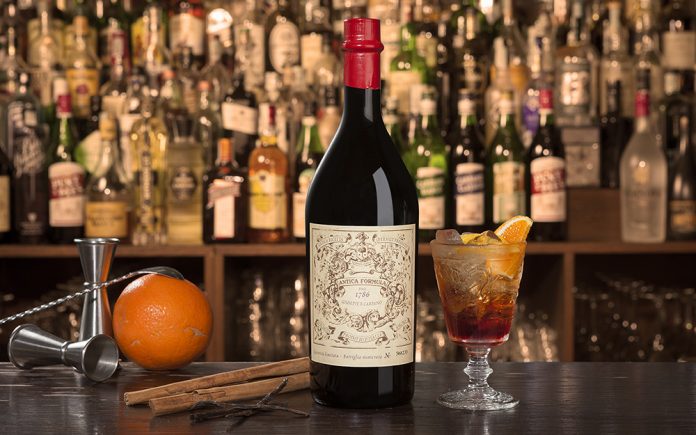
By Rick Riozza
Vermouth continues to sell off the shelves every week. Even in these Coronavirus times, with a limited number of shoppers out there, we’re still selling out—to the point that the warehouse that supplies us, was out of the product itself!
Indeed, vermouth first started as a medicinal remedy, but I think its sales are fueled by the gin boom and the resurgence of the Negroni, Manhattan, and Martini cocktail craze. (And it’s understandable if we’re imbibing a bit more these days.) However, on the rise of its popularity, some folks are still a little uncertain as to what Vermouth really is.
I continue to hear complaints as to where in the liquor department we keep our vermouth. When I first came to Ralphs, the dry vermouth was located by the gin section (for Martinis); the sweet vermouth by the whisk(e)ys (for Manhattans). It made sense to me; but being a “purest”, I liked it when we moved vermouth to the wine section—because, after all, it is a wine.
Vermouth is “fortified wine” along the lines of a port, sherry, or Madeira in that a neutral grape-based alcoholic spirit is added to fortify the alcohol content of the wine. Vermouth, however and thereafter, goes on its own path, when botanicals are added, thus entering into yet another category: a bitter.
In the same vein as vermouth, bitters are made by infusing—not wine—but a neutral spirit with any number of aromatics, including spices, tree bark, roots, seeds, fruits, etc. And vermouth is a wine that’s been infused with similar stuff.
Every so often, one can stump a wine nerd by asking what grapes are used to produce vermouth. And perhaps, through the hems and haws, we’ll get an answer that includes a trade of European whites: Clairette blanche, Catarratto, Trebbiano, Blanchetta Trevigiana, and Piquepoul to name a few.
Actually, the original Italian vermouth made by Antonio Carpano in the city of Torino back in 1786 or so, was quite egalitarian: He used grapes from Romagna towards the north of Italy, from Puglia in the south, and from Sicily in the Mediterranean. The top-notch, very reputable and famed Carpano Antica Vermouth Formula, which is the name of the brand’s vermouth label is still made with that exact recipe. The Antica Formula is a rich and unctuous vermouth with balanced vanilla notes that is ideal for sipping neat; and, the Antica Formula is fantastic when mixed into a Manhattan or even a Negroni cocktail.
Whatever white grapes are used in the vermouth blend, the base wine is then briefly aged before a specific amount of sugar syrup is added. Yep—that’s right, and that’s where we get the dry and the sweet versions of the veritable vermouth.
Historically, herb-infused wines have existed for millennia; for medicinal purposes of course since herbs are our natural healing plants. In the 18th Century, when better wines were making their strides in both France and Italy, alchemists in the day (known as bartenders in our day) were all about creating a brew that works and treats medically and entertainingly.
So when Carpano of Torino put together his “Rosso”, sweet red vermouth, he did have a prototype existing across the border in France of a “Sec” or “dry” style—made with a lot less added sugar, if much at all. Sooner or later, all types and styles of herb-infused wines, aka vermouths, sweet, dry or in the middle came on the market. And modernly, with craft distilling on the rise, we shall see innovating variations.
“Vermouth has a really broad array of applications. It is so versatile that it can be the star of a cocktail instead of sitting in the back seat,” explains Alan Lam, beverage director of NYC’s Eataly Flatiron. “The point in any cocktail is to make sure it is not overpowering or has a flavor that is all over the place.” For instance, “Whisk(e)y and vermouth naturally balance each other. Vermouth softens the more powerful whisk(e)y, and the result is a well-integrated cocktail. The applications are endless.”
Those looking for a lower-proof drink that can satisfy cravings while keeping the alcohol consumption in check, bartenders are experimenting with “reverse” cocktails, which switch the ratios. A reverse Manhattan would be 2 parts vermouth and 1 part whisk(e)y.
One can make sweet alcoholic cocktails utilizing sweet liquors and fruits & juices all day. But that alone—sooner or later becomes a cloying beverage. The younger set loves their sodas. The older set needs something a little more interesting. And that’s why we use vermouth and bitters to hit our taste buds, liven-up the drink and allow the complexities to intercede.
Bitters have such an established place in spirits and at the bar that nearly everyone recognizes the popular brand of bottled bitters: particularly Peychaud’s and Angostura Bitters. In a different class, orange bitters & liqueurs, clear orange-hued citrus bitters with a complex of lighter-spectrum flavors that vary from brand to brand—think of Grand Marnier and Cointreau.
Finally—some last thoughts on vermouth: Because it is a fortified wine, it lasts (or doesn’t sour) as quickly as typical white wine. Give it one to three months after being opened; and the best advice is to store in in the fridge for it to last up to five months. It’s also an excellent cooking wine and goes remarkably well in a risotto.
In most brands, generally the green bottle is a dry version and a red bottle is a sweet. However—check the label: in Italian, if the label has the term “Bianco” it’s a sweeter version of vermouth no matter the green bottle. Always look for “Extra Dry” for the least amount of dosage of sugar.
The top brands to look for include the Carpano Antica, already mentioned, Dolin Dry Vermouth, Noilly Prat Extra Dry, Martini & Rossi Riserva Speciale Ambrato, Cocchi, and the Martini & Rossi Extra Dry—in that order! Cheers!










































